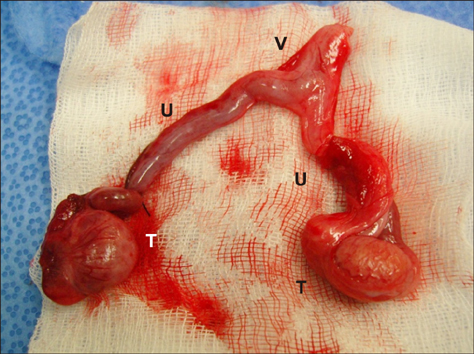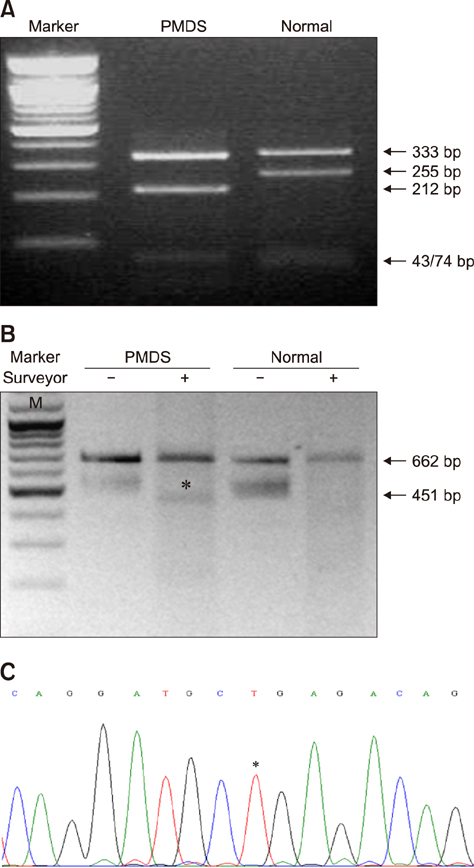J Vet Sci.
2017 Dec;18(4):547-549. 10.4142/jvs.2017.18.4.547.
Surveyor assay to diagnose persistent Müllerian duct syndrome in Miniature Schnauzers
- Affiliations
-
- 1Department of Nanobiomedical Science and BK21 PLUS NBM Global Research Center for Regenerative Medicine, Dankook University, Cheonan 31116, Korea. shim@dku.edu
- 2Dream Animal Hospital, Seoul 05570, Korea.
- 3Institute of Tissue Regeneration Engineering, Dankook University, Cheonan 31116, Korea.
- 4Department of Physiology, Dankook University School of Medicine, Cheonan 31116, Korea.
- KMID: 2398515
- DOI: http://doi.org/10.4142/jvs.2017.18.4.547
Abstract
- Persistent Müllerian duct syndrome (PMDS) is a pseudohermaphroditism in males characterized by the presence of Müllerian duct derivatives. As PMDS dogs often lack clinical symptoms, a molecular diagnosis is essential to identify the syndrome in these animals. In this study, a new molecular method using DNA mismatch-specific Surveyor nuclease was developed. The Surveyor nuclease assay identified the AMHR2 mutation that produced PMDS in a Miniature Schnauzer as accurately as that obtained by using the conventional method based on restriction digestion. As an alternative to the current molecular diagnostic method, the new method may result in increased accuracy when detecting PMDS.
MeSH Terms
Figure
Reference
-
1. Brown TT, Burek JD, McEntee K. Male pseudohermaphroditism, cryptorchism, and Sertoli cell neoplasia in three miniature Schnauzers. J Am Vet Med Assoc. 1976; 169:821–825.2. Guschin DY, Waite AJ, Katibah GE, Miller JC, Holmes MC, Rebar EJ. A rapid and general assay for monitoring endogenous gene modification. Methods Mol Biol. 2010; 649:247–256.
Article3. Matsuu A, Hashizume T, Kanda T, Nagano M, Sugiyama A, Okamoto Y, Hikasa Y. A case of persistent Müllerian duct syndrome with Sertoli cell tumor and hydrometra in a dog. J Vet Med Sci. 2009; 71:379–381.
Article4. Meyers-Wallen VN, Donahoe PK, Ueno S, Manganaro TF, Patterson DF. Müllerian inhibiting substance is present in testes of dogs with persistent Müllerian duct syndrome. Biol Reprod. 1989; 41:881–888.
Article5. Pujar S, Meyers-Wallen VN. A molecular diagnostic test for persistent Müllerian duct syndrome in Miniature Schnauzer dogs. Sex Dev. 2009; 3:326–328.
Article6. Qiu P, Shandilya H, D'Alessio JM, O'Connor K, Durocher J, Gerard GF. Mutation detection using Surveyor nuclease. Biotechniques. 2004; 36:702–707.
Article7. Vegter AR, Kooistra HS, van Sluijs FJ, van Bruggen LWL, Ijzer J, Zijlstra C, Okkens AC. Persistent Müllerian duct syndrome in a Miniature Schnauzer dog with signs of feminization and a Sertoli cell tumour. Reprod Domest Anim. 2010; 45:447–452.
Article8. Wu X, Wan S, Pujar S, Haskins ME, Schlafer DH, Lee MM, Myers-Wallen VN. A single base pair mutation encoding a premature stop codon in the MIS type II receptor is responsible for canine persistent Müllerian duct syndrome. J Androl. 2009; 30:46–56.
Article
- Full Text Links
- Actions
-
Cited
- CITED
-
- Close
- Share
- Similar articles
-
- Persistent Mullerian Duct Syndrome in a Boy with Transverse Testicular Ectopia: a Case Report
- A Case of Persistent Mullerian Duct Syndrome
- Radiography and ct features of atherosclerosis in two miniature schnauzer dogs
- A case of persistent Mullerian duct syndrome
- A Case of Persistent Mullerian Duct Syndrome



